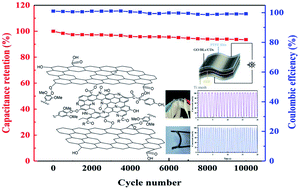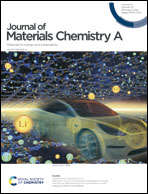Self-assembly of biomass-based hybrid hydrogel electrode for an additive-free flexible supercapacitor†
Abstract
Lignin-rich black liquor produced from paper-making industries causes severe eco-issues, and how to make full use of it to gain an environmental and economic balance has been gaining increasing attention. Herein, lignin materials from the black liquor are crosslinked and then self-assembled with graphene oxide and bio-based carbon dots by a microwave assisted hydrothermal method to prepare flexible hybrid hydrogels, which could then be employed as electrode materials for manufacturing flexible supercapacitors. This research reveals that for the ternary composite hydrogels, the black liquor lignin effectively inhibits the aggregation of graphene oxide, increases the ordered structure, and introduces sulfur-containing groups for the composites. The incorporation of carbon dots provides electron-rich regions to enhance electrical conductivity and reduce the charge transfer resistance. In addition, the pyridine-N-oxide groups that develop change the surface properties and promote the wettability of the composites. An additive free flexible solid-state symmetrical supercapacitor based on this functionalized hydrogel was fabricated and delivered a capacitance of 94 F g−1 at 0.5 A g−1 using lignin hydrogel electrolyte, and the energy density reaches 13.4 W h kg−1 at a power density of 150 W kg−1. Moreover, the solid-state symmetrical supercapacitor device also exhibits a promising flexible performance, which gives an insight into its potential applications as signal sensors and as portable energy storage.



 Please wait while we load your content...
Please wait while we load your content...